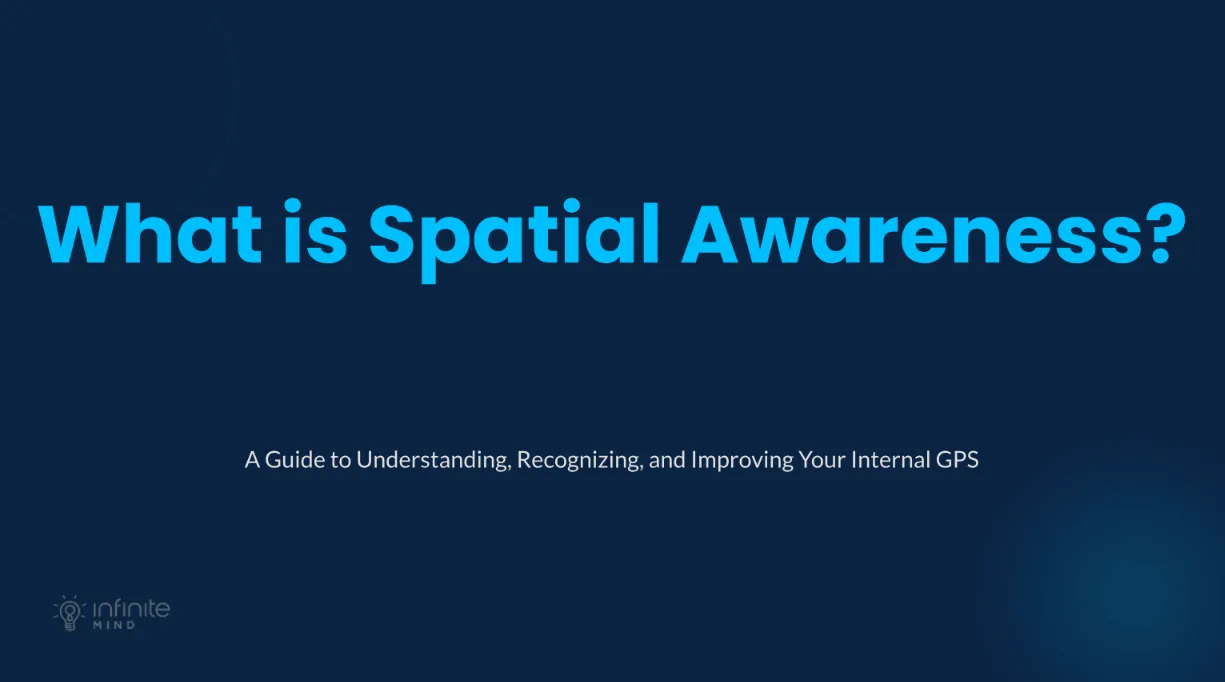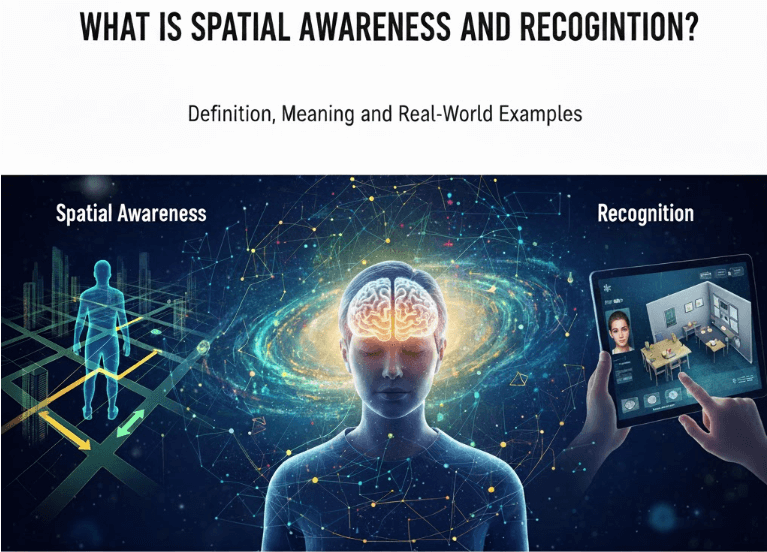At Infinite Mind, we don’t just study spatial awareness – we train it. Every day, we witness how this essential cognitive skill transforms performance across classrooms, workplaces, and even competitive sports.
After years of cognitive training and neuro-assessment, one thing has consistently remained common – there is a strong correlation between robust spatial recognition and brain efficiency. When your spatial awareness is strong, you will see an enhancement in your focus, you will also find memory skills that are reliable, and your problem-solving will be fast.
Why Spatial Recognition Matters
Your brain is just like a GPS, controlling every move and every decision like a precision GPS. Good spatial recognition increases efficiency in the brain, making you think faster, recall better, and problem-solve. Training these skills increases the ability to focus, improves mind agility, and gives you the confidence to approach challenges creatively and precisely. InfiniteMind.io translates these insights into practical exercises which help improve adaptability, resilience, and overall cognitive ability – useful in school, at work, and beyond.
Quick Answers
What is spatial awareness and recognition?
Spatial awareness is the brain’s ability to understand your body’s position in space and the relationships between objects in your environment-functioning like an internal GPS that processes visual, auditory, and tactile signals to help you navigate, judge distances, interpret depth, and coordinate movement. Real-world examples include driving (gauging distances and anticipating movements), parking in tight spaces, assembling furniture, reading maps, catching a ball, and any activity requiring you to understand how objects relate spatially. Strong spatial recognition enhances overall brain efficiency by improving focus, memory, problem-solving speed, and mental flexibility, and can be strengthened through brain training games, physical activities like yoga or dance, 3D puzzles, and balance exercises that connect mind and body coordination.
Top Takeaways
Your Brain’s GPS System
- Spatial awareness processes how your body and objects relate in 3D space
- Controls driving, navigation, problem-solving, and athletic performance
Amplifies All Cognitive Functions
- Faster thinking and better memory
- Sharper focus and creative problem-solving
- Foundation for success across all areas of life
Predicts Long-Term Success
- 4th-grade spatial skills predict STEM career pursuit
- Impact remains even when controlling for math ability and motivation
Trainable Through Daily Practice You can strengthen spatial awareness with:
- Brain training games and 3D puzzles
- Physical activities (yoga, dance, balance exercises)
- Mindfulness practices
- Just 7 minutes daily creates measurable improvements
Critical at Every Life Stage
- Childhood: Learning foundation and academic achievement
- Adulthood: Workplace performance and athletic precision
- Seniors: Independence, safety, and fall prevention

Ready to unlock your infinite mind? Just 7 minutes a day can transform how you learn, focus, and succeed. Download the Infinite Mind app and discover what you’re truly capable of.
Understanding The Concept of Spatial Recognition
Our minds understand space, and the world is organized around spatial concepts. It’s not just objects’ location that’s important, it’s relationships in space, sensory integration, and processing to effectively interact with your environment. “This cognitive capability influences every aspect of normal life, from navigating a crowded room to driving in an unfamiliar city.
At its most basic, it is useful for determining distances, seeing depth, and interpreting directions. It’s the brain’s way of combining the signals from sight, sound, and touch to construct a coherent understanding of your environment. Strong understanding helps with visual processing – the ability to recognize patterns, process visual information, and respond quickly to what you see. Together, these abilities make it possible for you to move through the world confidently and efficiently.
The Power of Spatial Recognition
A key component is spatial recognition-the brain’s ability to understand the position and orientation of objects in space. This skill isn’t just practical; it unlocks a range of cognitive advantages. It supports mental flexibility, helping you adapt to new situations, solve problems creatively, and navigate complex challenges with ease.
In daily life, it matters whenever you interpret a map, park in a tight space, or assemble furniture. Professionals rely on it too: architects and engineers visualize three-dimensional structures, and medical practitioners interpret imaging or perform intricate procedures.
Strengthening Your Abilities
This is like exercising your mind’s navigation and visualization muscles. Mental workouts-ranging from visual puzzles to constructing 3D models-train your brain to process spatial relationships more efficiently. Memory-based games, whether card matching or interactive digital environments, strengthen spatial memory while boosting attention and problem-solving skills.
Physical activities also contribute. Practices that require balance and coordination, such as yoga, dance, or martial arts, help you connect your body. It reinforces mental mapping abilities.
Through consistent practice, these exercises cultivate sharper attention, faster problem-solving, and improved memory. It becomes more than a skill-it becomes a foundation for overall cognitive performance.
Everyday Examples in Action
This is constantly at work in daily life. Driving demonstrates this clearly: you gauge distances, anticipate movements, and adjust your actions in real time. Problem-solving activities, like assembling furniture, challenge you to visualize and manipulate parts in three dimensions. Even sports highlight this ability: athletes continuously assess distances, trajectories, and positions to make precise decisions.
Your Next Steps to Sharpen It
You can strengthen this vital cognitive skill in practical, engaging ways:
- Brain Training Games: Challenge yourself with puzzles and interactive exercises that enhance spatial reasoning while keeping the experience enjoyable.
- Physical Activities: Yoga, dance, or balance-based exercises improve coordination and spatial perception.
- Focused Meditation: Developing your body and surroundings sharpens attention and cognitive control.
By taking care of it, you’re not just increasing specific cognitive skills – you’re increasing your overall mental capacity, fluidity, and authoritativeness in the world.

“After years of working closely with educators, athletes, and neuro-specialists, one thing has become undeniably true: spatial awareness isn’t a skill; it’s the foundation of adaptability. When your brain learns to understand better and navigate space, then not only improves coordination and focus but also improves the efficiency of every other cognitive system. That’s why at Infinite Mind, we are more than just theoretical. We teach your brain to think quicker, move smarter, and react more effectively in real-world situations.”
You’re capable of so much more. Start unlocking your learning potential today-get the Infinite Mind app and see what happens when you sharpen your focus and accelerate your growth.
Supporting Facts and Statistics
- Early Spatial Awareness Drives Future Success
- Children who develop spatial skills early gain a strong foundation for confidence in math, design, and problem-solving. Research funded by the NSF shows that 4th-grade spatial abilities can predict whether students pursue STEM majors in college-even when accounting for math proficiency and motivation. Source: par.nsf.gov
- Spatial Attention Impacts Everyday Safety
- It is critical for everyday safety. Distracted driving and lapses in spatial attention have real consequences: in 2022 alone, 3,308 deaths and 289,310 injuries in the U.S. were linked to distracted drivers. Source: nhtsa.gov
- Spatial Orientation Protects Aging Adults
- Its processing is vital for older adults’ independence. Over 14 million Americans aged 65 and older experience a fall each year-roughly 1 in 4 seniors. Falls are the leading cause of injury-related deaths and often result from misjudging distance or spatial positioning. Source: nhtsa.gov
Why It Matters
It isn’t just a mental skill-it’s a lifelong advantage that influences learning, safety, independence, and career growth. Whether in classrooms, workplaces, or senior living, investing in spatial development yields benefits at every stage of life.
Key Benefits Include:
- Enhances how you move, learn, and make decisions.
- Strengthens focus, memory, and adaptability.
- Improves performance in academics, professional settings, and sports.
What We’ve Learned at InfiniteMind.io
Through years of hands-on cognitive training and neuro-assessment, we’ve observed a consistent pattern:
- Improved spatial recognition accelerates cognitive processing.
- Learners retain information more effectively.
- Athletes and professionals respond with greater precision and confidence.
Our Perspective
Spatial cognition is one of the most undervalued frontiers in modern neuroscience. In an era dominated by automation and AI, human spatial skills remain a distinct advantage-shaping creativity, navigation, and intuitive decision-making.
At Infinite Mind, we believe cultivating it isn’t optional. It’s essential for anyone who wants to build a sharper, faster, and more adaptable mind. By investing in this ability, you’re not only enhancing cognitive performance-you’re unlocking your potential to succeed across every area of life.
Frequently Asked Questions
1. What are some examples of spatial awareness in real life?
Spatial awareness appears in countless everyday activities: parking a car, catching a ball, navigating through a crowded room, or judging personal space. It also helps with arranging furniture, reading maps, or pouring liquid into a glass without spilling. Essentially, any task that requires understanding how objects and your body relate in space relies on this skill.
2. What are the three types of spatial awareness?
The three key types are:
- Visual-spatial awareness: Understanding how objects relate to each other in space.
- Directional-spatial awareness: Navigating and orienting yourself-knowing left from right, up from down.
- Body-spatial awareness: Sensing your body’s position relative to your environment, which supports balance, movement, and coordination.
3. Which side of the brain is more associated with spatial awareness?
The right hemisphere of the brain plays a central role in spatial awareness. It processes visual and spatial information, recognizes patterns, and helps interpret distance, shape, and direction accurately.
4. What is it called when you have good spatial awareness?
Strong spatial awareness is often referred to as high spatial intelligence or strong spatial reasoning skills. People with this ability can visualize objects in space, mentally rotate shapes, and understand spatial relationships with ease.
5. What are the signs of a lack of spatial intelligence?
Challenges with spatial intelligence can appear as difficulty reading maps, assembling furniture, judging distances, or navigating spaces. People may bump into objects, struggle with directions, or find it hard to visualize how things fit together.
6. Are people with ADHD left- or right-brained?
ADHD doesn’t strictly align with left- or right-brain dominance. However, research suggests that many individuals with ADHD leverage right-brain strengths like creativity and spatial reasoning while finding highly structured, left-brain tasks-such as organization and sequencing-more challenging.
7. What are spatial thinkers good at?
Spatial thinkers excel at visualizing, designing, and solving problems involving physical space. They often shine in art, architecture, engineering, navigation, gaming, and pattern recognition-anywhere understanding spatial relationships is key.
8. What does it mean when someone lacks spatial awareness?
A person with limited spatial awareness may struggle to judge distances, misplace objects, or bump into things. They may find it difficult to follow visual or directional cues, which can affect navigation, coordination, and everyday tasks.
9. What is the opposite of spatial awareness?
The opposite is spatial neglect or disorientation, where a person has difficulty perceiving spatial relationships or responding accurately to their environment.
10. What are the signs of a person with high spatial intelligence?
Someone with strong spatial intelligence can easily visualize three-dimensional forms, think through puzzles or designs, and mentally manipulate objects. They often enjoy activities like drawing, building, or working with visual patterns, and they learn effectively through visual input.
11. What jobs can people with high spatial intelligence do?
Careers that benefit from strong spatial intelligence include architecture, engineering, graphic and interior design, surgery, animation, aviation, and urban planning. These roles demand visualization, precision, and creative problem-solving.
12. What is spatial awareness?
Spatial awareness is the ability to understand your body’s position in space and the relationship between objects. It helps you move safely, interpret visual information, and perform tasks that require coordination, navigation, and depth perception.
Imagine finally reading those books on your shelf, mastering new skills, and feeling confident in every conversation. It starts with better focus. Download Infinite Mind and take the first step today.















